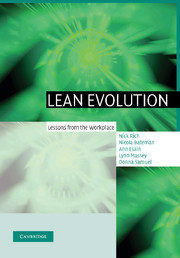Book contents
- Frontmatter
- Contents
- List of boxes
- List of figures
- List of tables
- Glossary
- 1 Introduction
- 2 Understanding the lean journey
- 3 Understanding your organisation
- 4 Laying the foundation stone of CANDO
- 5 Visual management and performance measurement
- 6 Problem solving, TQM and Six Sigma
- 7 Pull systems
- 8 Total productive manufacturing (TPM)
- 9 Sustainability
- 10 Group learning
- 11 Reflections and future challenges
- References
- Index
2 - Understanding the lean journey
Published online by Cambridge University Press: 17 August 2009
- Frontmatter
- Contents
- List of boxes
- List of figures
- List of tables
- Glossary
- 1 Introduction
- 2 Understanding the lean journey
- 3 Understanding your organisation
- 4 Laying the foundation stone of CANDO
- 5 Visual management and performance measurement
- 6 Problem solving, TQM and Six Sigma
- 7 Pull systems
- 8 Total productive manufacturing (TPM)
- 9 Sustainability
- 10 Group learning
- 11 Reflections and future challenges
- References
- Index
Summary
Introduction
The market for manufactured products is getting more and more competitive. There is no such thing now as a safe product or a safe market. Even companies that previously had a monopoly position, such as telecommunications, gas or electricity corporations, have found themselves deregulated or the target of consumer groups. These changes add up to the new competitive world within which consumers and customers have greater power and increasingly demand higher levels of customer service and greater value (Womack and Jones, 1996). To compound these changes, Western manufacturers face a new threat ‘from the East’, as India, China and former soviet bloc countries, each with massive reserves and large numbers of manufacturing firms, increasingly look to sell products into Europe. These ‘exports’ drive up the levels of competition and therefore no Western firm can afford to stand still and not to become involved in factory-wide improvement activities. Failing to understand the new competitive environment is one way to lose market share and another is not to improve to protect customers and keep them loyal, as other businesses compete to trade with them.
These competitive conditions have generated a new ‘set of rules’ for Western manufacturers. These new rules include the provision of the highest level of customer service, the delivery of quality products in shorter and shorter lead times and product proliferation to offer variety to customers (McCarthy and Rich, 2004).
- Type
- Chapter
- Information
- Lean EvolutionLessons from the Workplace, pp. 11 - 31Publisher: Cambridge University PressPrint publication year: 2006
Accessibility information
- 1
- Cited by

